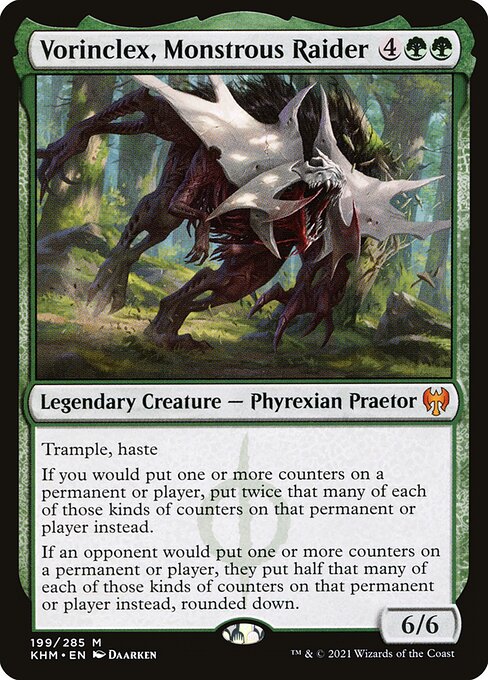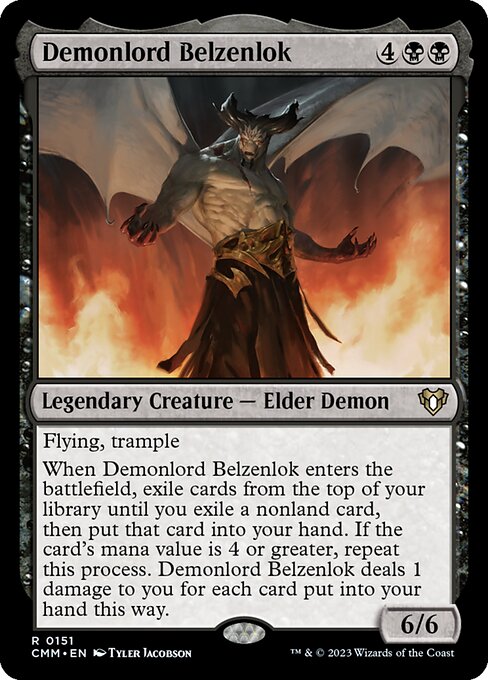Recently, I’ve been grinding my way up the February Standard ladder on Arena with a Superfriends deck built around Vorinclex, Monstrous Raider. The trifecta of Vorinclex, Ugin, the Spirit Dragon, and Valki, God of Lies offer a powerful coreforf any deck, particularly when they’re powered out with Dream Devourer, which allows you to Foretell Vorinclex on three and cast on four as a massive Questing Beast-style threat.

The deck is a modified version of a SaffronOlive list that caught my eye a month ago; since picking it up, I’ve been impressed by its performance. On Arena, at least, Sagas proliferate—or, with Vorinclex out, fail to proliferate—and it’s amazing to watch someone go in the tank after attempting to steal him with The Akroan War. I’ve gotten several concessions once people realize their Binding the Old Gods can’t deal with him and that mine trigger twice immediately, and Ugin going ultimate on arrival has drawn even more.
In theory, Vorinclex is not hard to interact with. Any hard removal can deal with him, but as people are drawn to the card advantage perks of Sagas, they tend to cut Murderous Rider and Heartless Act. Doomskar and Extinction Event are great, but they’re less appealing when you’ve already taken six damage. Here’s where I am with the deck, which has cut the non-Tibalt Red in the main deck in favor of splashing for the sideboard—which is hilariously plausible, now that the Pathways make a splash trivial.
Standard Jund Superfriends
There’s something perfect about how Vorinclex neutralizes Sagas. Sagas in Magic are a way of saying “we were here, and we mattered.” They’re reflections of Magic’s varied cultures designed to honor whatever that culture considered important. I can’t praise Sagas enough, honestly. The design is elegant and understandable, and they open up in-game continuity to the lore without forcing it. So far, they’ve also been superbly well-designed—in a year where we’ve seen card after card banned, no one Saga is even in the conversation, unlike their closest analogue, Planeswalkers.
So for Vorinclex to invalidate Sagas in another way to demonstrate how Phyrexia doesn’t just mutate creatures, but rewrite the entirety of previous cultures—there is no more Mirrodin, only New Phyrexia. The scariest part of original Phyrexia (which Wizards cannily retained in New Phyrexia) was the complete surrender of personal identity into being a servant of the machine. When bodies can be casually harvested, dissected, reassembled, and modified in the service of the same communal goal, what does “identity” matter? More to the point, when you’re becoming an unnatural abomination of flesh, steel, and glistening oil, who care about the death of some troll? The only thing that matters is progress, and “progress” only looks like “predation” to prey animals.
We’ve gotten used to the gameplay of Sagas and how they give us situational but recurring card advantage. In charges Vorinclex, Monstrous Raider, and takes that away from us—not in a problematic way, in the way that Flametongue Kavu invalidated every X/4 creature, but in a way that feels flavorful and disruptive. Our Sagas still hit the board, but they sit there, useless until we can deal with the massive Praetor. We feel imprisoned and helpless while meanwhile, Vorinclex’s owner gets to double up on their own Sagas—and Planeswalkers, and poison counters, and +1/+1 counters, and so on. It feels wrong: uncanny and unfair, but not in the same way that other bombs have felt. Bad designs warp formats; good designs warp individual games.

More than anything, Vorinclex reminds me of another 6/6 for six: Demonlord Belzenlok. Dominaria offered a savvy reboot of the Cabal with the Demonlord as the new Patriarch; instead of being just another retread villain, it became a metacommentary on retreads. Belzenlok took on the identity of old villains—not as a shapeshifter or a mysterious puppetmaster, but as an insecure poseur. For him to matter as an antagonist, he had to borrow two decades of Magic lore and recast himself as Magic’s eternal villain. Similarly, Vorinclex is New Phyrexia’s first foray into the larger multiverse since taking over Mirrodin.
Vorinclex’s presence on Kaldheim means he has to embody the plane for people (both in the game and in the lore) who are unfamiliar with what Phyrexians are, and he does that well. His size and abilities suggest his goal of becoming the perfect predator, and the cruelty of his counter doubling and restricting ability underscores the maliciousness of Phyrexia. Wizards has to build worlds not just around factions and guilds and evocative names, but with the individual stories cards tell. Both Vorinclex and Belzenlok do so with as much charm as effectiveness.
Other huge, powerful creatures have been generically powerful—Griselbrand, various Eldrazi—whereas these two six-drops meld attractive stats with potent-but-situational abilities. It’s possible for Belzenlok to take you out of the game from casting him—his card draw ability is technically a drawback. Just having that potential Faustian twist makes him a more interesting card than your beater of choice—and kept him out of tournament contention—much as Vorinclex’s counter ability draws you to build around it, even if his stats are good enough on their own merits. Belzenlok’s tension comes within the game, while Vorinclex’s comes in the deck building. It took me a long time to arrive at the right mix of Sagas, Planeswalkers, and Vorinclexes. (Vorinclexen?) Even then, I sometimes get the dreaded three land, Ugin, Vorinclex, Valki hand.
The rewriting of history heralded by Vorinclex goes beyond Sagas: Wizards of the Coast announced that, with the release of Kaldheim, “Phyrexian” would become a supported creature type. Notably, though, they’re slow rolling the addition of this type to other creatures, with only Vorinclex and noncanonical Vazal, the Compleat currently counting. Obviously, the other Praetors will get errata to reflect this, but will Plague Engineer be compleated? Devouring Strossus? Will Phyrexian Dreadnought join Plant Elemental and Merfolk Assassin as cards whose names are the same as their creature types?
We’re not returning to Phyrexia in an announced set, but Wizards have set up foreshadowing for an eventual return. In much the same way that Vorinclex benefits Infect without mentioning poison counters directly, his presence on Kaldheim hangs over us without a promise of an immediate visit to the plane. My suspicion is that Wizards was looking for a Grendel equivalent for their Viking set and, rather than create a new Legend, went with a popular Legendary creature who could fulfill that role and drum up excitement amongst enfranchised players. It worked, and it worked because Vorinclex has a dominant legacy, one that subsumes others and warps them—a role only a Phyrexian can play.
A lifelong resident of the Carolinas and a graduate of the University of North Carolina, Rob has played Magic since he picked a Darkling Stalker up off the soccer field at summer camp. He works for nonprofits as an educational strategies developer and, in his off-hours, enjoys writing fiction, playing games, and exploring new beers.

